General
Why For?
In the long-delayed return of this popular JHM feature, Jim Hill answers your questions about Disneyland’s “Partners” statue, “Dumbo 2” as well as what’s going on with the Pixar negotiations.

Ben B. writes in to ask:
Jim,
This is from (this week’s “DizBiz” column):
“By the way, there’s an interesting story about how the Partners statue came to be in the center of the Hub at Disneyland. There isn’t time to tell it here. Let’s just say it has to do with one of Imagineering’s better ideas for keeping the “suits” from ruining Disneyland’s sightlines. If you’d like to know more drop Jim a line and ask him to tell you the whole story.”
I’d be very interested to hear this story.
Thanks,
Ben
Dear Ben:
This particular story isn’t one of mine. It’s actually one that my ex-wife — Michelle Smith AKA the Fabulous Disney Babe — used to feature on her tour of Disneyland. Michelle has been gracious enough to allow me to “borrow” this anecdote from time to time (provided, of course, that I always give her credit for this story).
Anyway … If you talk with the Guest Relations staff at Disneyland, WDW’s Magic Kingdom, Tokyo Disneyland and/or Walt Disney Studios – Paris, they’ll tell you that the reason that the “Partners” statue was placed in their theme park was because the Walt Disney Company wanted to honor its founder, Walt Disney.
However, were you to talk to the Imagineers who actually originated the “Partners” project (particularly the original incarnation of the statue, which stands in the planter in the center of Disneyland’s Hub), they’d tell you a very different story as to why Mickey and Walt occupy that particular spot in the Anaheim theme park.
So what’s the deal? How many of you remember the mid-1980s? That intriguing time right after Michael Eisner came on board as the new head of Walt Disney Productions. Back when Uncle Mike was determined to do anything he could to increase attendance levels at the Disney theme parks.
Given that building brand new E-Tickets like “Star Tours” and “Splash Mountain” — attractions that were sure to bring crowds back to Disneyland and Walt Disney World — was going to take a couple of years (and tens of millions of dollars), Eisner was looking for interim fixes back then. Some sort of temporary special events that could be staged inside the parks that would bring guests back to Anaheim and Orlando. Particularly during the off-season.
Which is how we ended up with months-long entertainments like the “Blast to the Past” (which celebrates the music and pop culture of the 1950s), “Disneyland State Fair” (which brought such unique entertainments as pig races and pie eating contests to the park) and “Circus Fantasy.”
It was “Circus Fantasy” that particularly irked the Imagineers. Why for? Because — even more than the “Disneyland State Fair” (which erected a ferris wheel directly in front of the Main Street train station … which — according to many of the guys at WDI — totally ruined the carefully crafted story telling of Walt’s theme park ) — the circus really disrupted Disneyland. Particularly when the Special Events staff did things like placing a motorcycle “Cage of Death” right in the center of the Hub.
As they stood there, watching a motorcycle zoom ’round and ’round in front of Sleeping Beauty Castle, the Imagineers talked amongst themselves. “We’ve got to stop this. Otherwise, they’ll just come back every year and put something really stupid in front of the castle. Something that will totally ruin Disneyland’s theming and storytelling.”
So one of the guys at WDI chimes in and says “Well, what if we were to put a statue in the center of the Hub? Of, say, Walt … and Mickey! They’d never take something like that down. If we put something like that in place here, the Special Events guys would never be able to put another ‘Cage of Death’ or Ferris Wheel here.”
That’s why the Imagineers contacted master sculptor Blaine Gibson and initiated the “Partners” project. Not because they really wanted to honor Uncle Walt. But rather, because they just didn’t want to see another “Cage of Death” in front of Sleep Beauty Castle.
Intriguing story, don’t you think? Well, this is just the sort of great behind-the-scenes story that you’ll get to hear if you take my ex-wife’s course — “Manufacturing the Magic: The History of Disneyland and Growth of the American Theme Park” (course number F5B01) — which will be held over three Saturdays starting on May 24th.
This course is will be a full blown examination of the history of the American theme park. The classes — which will run from 9 a.m. to 4 p.m. — will feature guest speakers. Including yours truly. Who will be detailing how the construction of Disneyland knock-offs like New England’s Pleasure Island and Southern California’s Pacific Ocean Pier actually drove Walt Disney to aggressively expand his own Anaheim theme park.
Registration for the class — which takes place at LTU’s Orange County campus — is already underway. To register, just call LTU at 714-427-0588. The cost of the class is $129.00. Class times are 9:00 am to 4:00 pm.
If you can’t make it out to Costa Mesa to physically take part in Michelle’s class … not to worry. My ex — working with the nice folks over at iuniversityonline.com — has also cooked up an on-line version of her “Manufacturing the Magic” theme park class. To learn more about the on-line version of this class, follow this link.
You wanna know the best part of Fab’s “Manufacturing the Magic: The History of Disneyland and Growth of the American Theme Park” course? The class will conclude with Michelle leading the folks who’ve signed up for the LTU version of the class on one of her highly acclaimed tours of Disneyland (theme park admission NOT included). On this tour, you’ll get to hear all about stuff that never made it off WDI’s drawing board. Full blown lands like Discovery Bay and Big City U.S.A.
So be sure to check it out. Okay … enough with the gratuitous plugs for the mother of my child. Let’s move on to other subjects, shall we?
Next, Matt M. writes in to ask:
Hi Jim — first time/long time, really love your site. Quick question: as much as I have come to loathe Disney DTV sequels (with good reasons aplenty, but that’s neither here nor there), I have always had a weakness for Dumbo (my favorite Disney film ever!).
The Dumbo DVD, released in Autumn 2001, showed some fluffy promotional material for Dumbo 2, just enough to get me interested. Since then I haven’t heard a peep, and I noticed it wasn’t on your extensive BVHE report. Is there any word on this release?
Thanks a bunch,
Matt M.
Ah, yes. “Dumbo 2.” This project — along with “Bambi 2” — is currently on hold. Why for? Because Disney Television Animation is still trying to decide whether or not it wants to go forward with CG sequels to both of these classics.
That’s right. A computer animated follow-up to both “Bambi” and “Dumbo.” I know that may sound sacrilegious to some of you Disneyana fans out there. But Disney was serious enough about this idea that it had Joe Grant, the 95-year-old Mouse House vet who was actually the supervisor of story of “Dumbo” back in 1940-1941, come in last year to view test footage of several CG versions of the flying pachyderm.
Unfortunately (or fortunately, depending on how you feel about CGI squeezing out traditional animation as Hollywood’s choice du jour), none of the Dumbo test footage was quite up to snuff. So Disney Television Animation opted to put “Dumbo 2” and “Bambi 2” on hold for a year or two. ‘Til enough advances can be made in computer animation so that direct-to-home-video-and-DVD sequels could be produced to these 1940s era Disney classics that actually looked like the original animated films.
So a little more patience is necessary, Matt. “Dumbo 2” is coming. As soon as someone teaches 2003 era computers (and — more importantly — 2003 era computer animators) how to ape the look and style of Disney’s master animators.
And finally, Mark B. writes to asks:
I just got done reading your very informative and interesting article regarding the Disney/Pixar relationship over at Digital Media FX.
I thought Finding Nemo would be Pixar’s 4th film in their 5 film contract.
1) Toy Story
2) A Bug’s Life
3) Monster’s Inc
4) Finding Nemo
5) The IncrediblesI know Toy Story 2 doesn’t count toward the deal, but I don’t know why Cars would be number 5 and end the 5 picture deal. Do you know? Thanks.
Mark B.
Mark,
What you need to understand is that the Walt Disney Company and Pixar Animation Studios are actuallly in the middle of their third deal negotiation. Their first agreement — which Michael Eisner and Steve Jobs signed off on ‘way back in 1991 — was just for three films. But — when “Toy Story” turned out to be such a monstrous hit when it hit theaters back November 1995 — Disney quickly decided that it had to renegotiate its deal with Pixar.
That second pact — which was announced February 24, 1997 — called for Pixar Animation Studios (starting with its November 1998 release, “A Bug’s Life”) to deliver five new feature length films to Walt Disney Pictures. So — (as you already mentioned, Mark) given that “Toy Story 2” doesn’t count toward the completion of this pact — the five pictures covered by the second Disney / Pixar deal are:
1) “A Bug’s Life” (November 1998)
2) “Monsters, Inc.” (November 2001)
3) “Finding Nemo” (May 2003)
4) “The Incredibles” (Holiday Season 2004)
5) “Cars” (2005 release date yet to be determined)
And what’s the current status on the negotiations for a third Disney/Pixar deal? Disney insiders has been quoted as saying that Mouse House executives expect to spend most of the month of June to trying to wrap up their negotiations with Steve Jobs. Jobs is said to be pushing for another three picture deal, rather than agreeing to yet another five film extension of Pixar’s current arrangement with Disney Feature Animation. And two of the proposed titles on the table (in an effort to get Mickey to sign off on the deal) are the sure-to-be-hits “Toy Story III” and “Monsters, Inc. II.”
Unfortunately, given the financial terms that Steve Jobs is now trying to get Michael Eisner to sign off on (Jobs is said to be modeling his new Disney deal on the one George Lucas was able to get 20th Century Fox to agree to in order to land “Star Wars I – III.” In which Fox only got a 5-7% distribution fee, while Lucas got to keep the bulk of the box office), it’s now seem only 60% likely that Disney will actually go forward with extending its Pixar pact. Which may explain why Pixar Animation Studio is already actively developing its first post-Disney feature. A film that’s reportedly built around the premise of the adventures of a mouse who lives inside on a tony New York City restaurant.
Given that I’d like to see “Toy Story III” and/or a sequel to “Monsters, Inc.” I’m hoping that Disney and Pixar are actually able to come to terms regarding yet another extension of their deal. But since there are so many variables right now (I’m told that a lot is depending on how well “Finding Nemo” does during its first two weeks at the box office. If the film does really well, Jobs may feel compelled to spur Disney’s deal and strike out on his own. If “Nemo” somehow manages to under-perform, Disney may think that it can now push for better financial terms … which may also result in the third deal getting derailed), it’s hard to predict what’s actually going to happen.
Still, given that Eisner is still smarting over the fact that the Muppets (a deal that Uncle Mike was SURE was already in the bag) got away, I’d imagine that he’s going to play it extra safe with the Pixar negotiations. Dotting all the I’s. Crossing all the T’s. Doing everything he can to make sure that this one doesn’t unravel in front of his eyes.
Given that Forbes has already singled Eisner out as the worst CEO in the country, Uncle Mikey can’t afford any more bad news right about now. Which is why (I’m betting here) that — when push comes to shove — Disney’s CEO will agree to whatever Jobs is asking. Just so the Mouse can avoid yet another series of “Disney Blows It … Again” headlines in the financial press.
Okay. That’s it for this week’s “Why For.” I’ll be back next week with even more stories … as well as a couple of special announcements. Talk to you then, okay?
Have a great weekend,
jrh
General
Seward Johnson bronzes add a surreal, artistic touch to NYC’s Garment District

Greetings from NYC. Nancy and I drove down from New
Hampshire yesterday because we'll be checking out
Disney Consumer Products' annual Holiday Showcase later today.
Anyway … After checking into our hotel (i.e., The Paul.
Which is located down in NYC's NoMad district), we decided to grab some dinner.
Which is how we wound up at the Melt Shop.
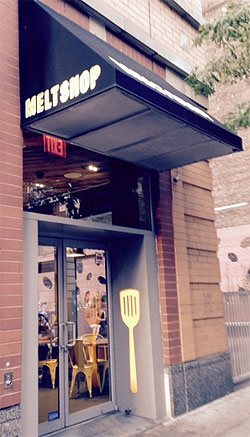
Photo by Jim Hill
Which is this restaurant that only sells grilled cheese sandwiches.
This comfort food was delicious, but kind of on the heavy side.

Photo by Jim Hill
Which is why — given that it was a beautiful summer night
— we'd then try and walk off our meals. We started our stroll down by the Empire
State Building
…
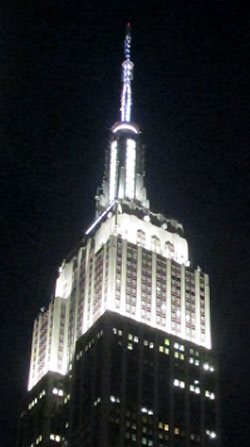
Photo by Jim Hill
… and eventually wound up just below Times
Square (right behind where the Waterford Crystal Times Square New
Year's Eve Ball is kept).

Photo by Jim Hill
But you know what we discovered en route? Right in the heart
of Manhattan's Garment District
along Broadway between 36th and 41st? This incredibly cool series of life-like
and life-sized sculptures that Seward
Johnson has created.

Photo by Jim Hill
And — yes — that is Abraham Lincoln (who seems to have
slipped out of WDW's Hall of Presidents when no one was looking and is now
leading tourists around Times Square). These 18 painted
bronze pieces (which were just installed late this past Sunday night / early
Monday morning) range from the surreal to the all-too-real.
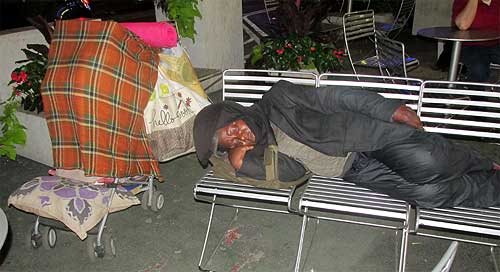
Photo by Jim Hill
Some of these pieces look like typical New Yorkers. Like the
business woman planning out her day …

Photo by Jim Hill
… the postman delivering the mail …

Photo by Jim Hill
… the hot dog vendor working at his cart …

Photo by Jim Hill
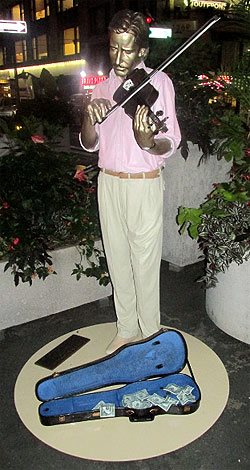
Photo by Jim Hill
… the street musician playing for tourists …

Photo by Jim Hill
Not to mention the tourists themselves.
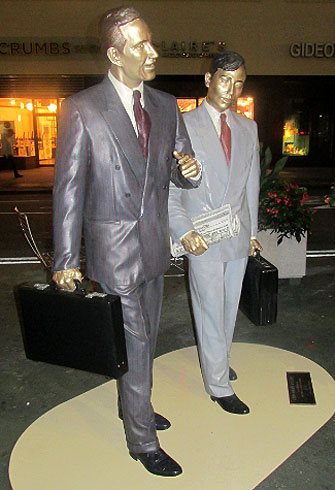
Photo by Jim Hill
But right alongside the bronze businessmen …

Photo by Jim Hill
… and the tired grandmother hauling her groceries home …
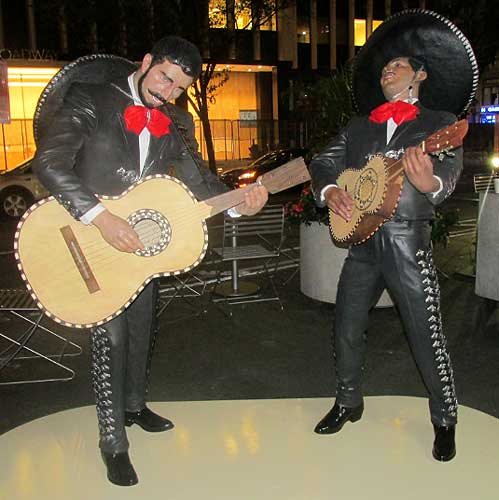
Photo by Jim Hill
… there were also statues representing people who were
from out-of-town …

Photo by Jim Hill
… or — for that matter — out-of-time.

Photo by Jim Hill
These were the Seward Johnson pieces that genuinely beguiled. Famous impressionist paintings brought to life in three dimensions.

Note the out-of-period water bottle that some tourist left
behind. Photo by Jim Hill
Some of them so lifelike that you actually had to pause for
a moment (especially as day gave way to night in the city) and say to yourself
"Is that one of the bronzes? Or just someone pretending to be one of these
bronzes?"
Mind you, for those of you who aren't big fans of the
impressionists …

Photo by Jim Hill
… there's also an array of American icons. Among them
Marilyn Monroe …
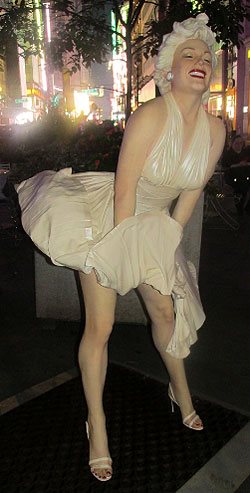
Photo by Jim Hill
… and that farmer couple from Grant Wood's "American
Gothic."

Photo by Jim Hill
But for those of you who know your NYC history, it's hard to
beat that piece which recreates Alfred Eisenstaedt's famous photograph of V-J Day in Times Square.

Photo by Jim Hill
By the way, a 25-foot-tall version of this particular Seward
Johnson piece ( which — FYI — is entitled "Embracing Peace") will actually
be placed in Times Square for a few days on or around August 14th to commemorate the 70th
anniversary of Victory Over Japan Day (V-J Day).

Photo by Jim Hill
By the way, if you'd like to check these Seward Johnson bronzes in
person (which — it should be noted — are part of the part of the Garment
District Alliance's new public art offering) — you'd best schedule a trip to
the City sometime over the next three months. For these pieces will only be on
display now through September 15th.
General
Wondering what you should “Boldly Go” see at the movies next year? The 2015 Licensing Expo offers you some clues

Greeting from the 2015 Licensing Expo, which is being held
at the Mandalay Bay
Convention Center in Las
Vegas.

Photo by Jim Hill
I have to admit that I enjoy covering the Licensing Expo.
Mostly becomes it allows bloggers & entertainment writers like myself to
get a peek over the horizon. Scope out some of the major motion pictures &
TV shows that today's vertically integrated entertainment conglomerates
(Remember when these companies used to be called movie studios?) will be
sending our way over the next two years or so.
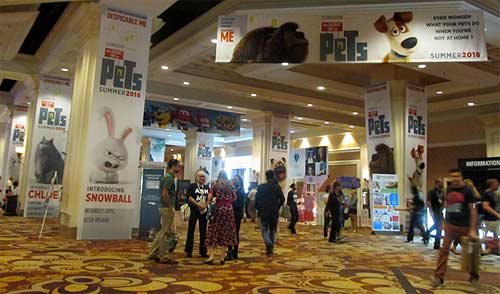
Photo by Jim Hill
Take — for example — all of "The Secret Life of
Pets" banners that greeted Expo attendees as they made their way to the
show floor today. I actually got to see some footage from this new Illumination
Entertainment production (which will hit theaters on July 8, 2016) the last time I was in Vegas. Which
was for CinemaCon back in April. And the five or so minutes of film that I viewed
suggested that "The Secret Life of Pets" will be a really funny
animated feature.

Photo by Jim Hill
Mind you, Universal Pictures wanted to make sure that Expo
attendees remembered that there was another Illumination Entertainment production
coming-to-a-theater-near-them before "The Secret Life of Pets" (And
that's "Minions," the "Despicable Me" prequel. Which
premieres at the Annecy International Animated Film Festival next week but
won't be screened stateside 'til July 10th of this year). Which is why they had
three minions who were made entirely out of LEGOS loitering out in the lobby.

Photo by Jim Hill
And Warner Bros. — because they wanted "Batman v
Superman: Dawn of Justice" to start trending on Twitter today — brought
the Batmobile to Las Vegas.
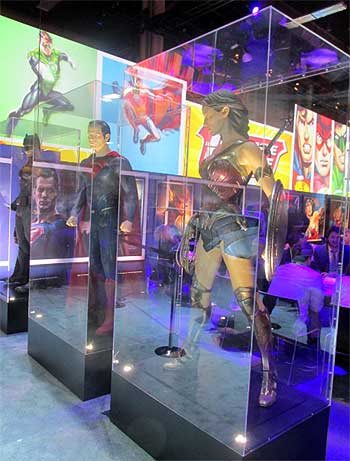
Photo by Jim Hill
Not to mention full-sized macquettes of Batman, Superman and
Wonder Woman. Just so conventioneers could then see what these DC superheroes
would actually look like in this eagerly anticipated, March 25, 2016 release.

Photo by Jim Hill
That's the thing that can sometimes be a wee bit frustrating
about the Licensing Expo. It's all about delayed gratification. You'll come
around a corner and see this 100 foot-long ad for "The Peanuts Movie"
and think "Hey, that looks great. I want to see that Blue Sky Studios production
right now." It's only then that you notice the fine print and realize that
"The Peanuts Movie" doesn't actually open in theaters 'til November
6th of this year.

Photo by Jim Hill
And fan of Blue Sky's "Ice Age" film franchise are in for an even
longer wait. Given that the latest installment in that top grossing series
doesn't arrive in theaters 'til July
15, 2016.

Photo by Jim Hill
Of course, if you're one of those people who needs immediate
gratification when it comes to your entertainment, there was stuff like that to
be found at this year's Licensing Expo. Take — for example — how the WWE
booth was actually shaped like a wrestling ring. Which — I'm guessing — meant
that if the executives of World Wrestling Entertainment, Inc. didn't like
the offer that you were making, they were then allowed to toss you out over the
top rope, Royal Rumble-style.

Photo by Jim Hill
I also have to admit that — as a longtime Star Trek fan —
it was cool to see the enormous Starship Enterprise that hung in place over the
CBS booth. Not to mention getting a glimpse of the official Star Trek 50th
Anniversary logo.
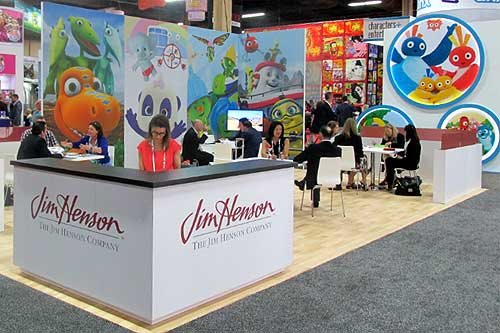
Photo by Jim Hill
I was also pleased to see lots of activity in The Jim Henson
Company booth. Which suggests that JHC has actually finally carved out a
post-Muppets identity for itself.

Photo by Jim Hill
Likewise for all of us who were getting a little concerned
about DreamWorks Animation (what with all the layoffs & write-downs &
projects that were put into turnaround or outright cancelled last year), it was
nice to see that booth bustling.

Photo by Jim Hill
Every so often, you'd come across some people who were
promoting a movie that you weren't entirely sure that you actually wanted to
see (EX: "Angry Birds," which Sony Pictures Entertainment / Columbia
Pictures will be releasing to theaters on May 20, 2016). But then you remembered that Clay Kaytis —
who's this hugely talented former Walt Disney Animation Studios animator — is
riding herd on "Angry Birds" with Fergal Reilly. And you'd think
"Well, if Clay's working on 'Angry Birds,' I'm sure this animated feature
will turn out fine."

Photo by Jim Hill
Mind you, there were reminders at this year's Licensing Expo
of great animated features that we're never going to get to see now. I still
can't believe — especially after that brilliant proof-of-concept footage
popped up online last year — that Sony execs decided not to go forward
with production of Genndy Tartakovsky's
"Popeye" movie. But that's the
cruel thing about the entertainment business, folks. It will sometime break
your heart.

Photo by Jim Hill
And make no mistake about this. The Licensing Expo is all
about business. That point was clearly driven home at this year's show when —
as you walked through the doors of the Mandalay
Bay Convention Center
— the first thing that you saw was the Hasbros Booth. Which was this gleaming,
sleek two story-tall affair full of people who were negotiating deals &
signing contracts for all of the would-be summer blockbusters that have already
announced release dates for 2019 & beyond.

Photo by Jim Hill
"But what about The Walt Disney Company?," you
ask. "Weren't they represented on the show floor at this year's Licensing
Expo?" Not really, not. I mean, sure. There were a few companies there hyping
Disney-related products. Take — for example — the Disney Wikkeez people.
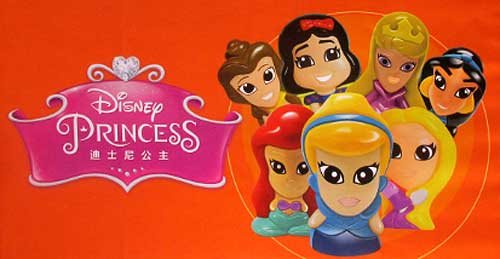
Photo by Jim Hill
I'm assuming that some Disney Consumer Products exec is
hoping that Wikkeez will eventually become the new Tsum Tsum. But to be blunt,
these little hard plastic figures don't seem to have the same huggable charm
that those stackable plush do. But I've been wrong before. So let's see what
happens with Disney Wikkeez once they start showing up on the shelves of the
Company's North American retail partners.

Photo by Jim Hill
And speaking of Disney's retail partners … They were
meeting with Mouse House executives behind closed doors one floor down from the
official show floor for this year's Licensing Expo.

Photo by Jim Hill
And the theme for this year's invitation-only Disney shindig? "Timeless
Stories" involving the Disney, Pixar, Marvel & Lucasfilm brands that
would then appeal to "tomorrow's consumer."

Photo by Jim Hill
And just to sort of hammer home the idea that Disney is no
longer the Company which cornered the market when it comes to little girls
(i.e., its Disney Princess and Disney Fairies franchises), check out this
wall-sized Star Wars-related image that DCP put up just outside of one of its
many private meeting rooms. "See?," this carefully crafted photo
screams. "It isn't just little boys who want to wield the Force. Little
girls also want to grow up and be Lords of the Sith."
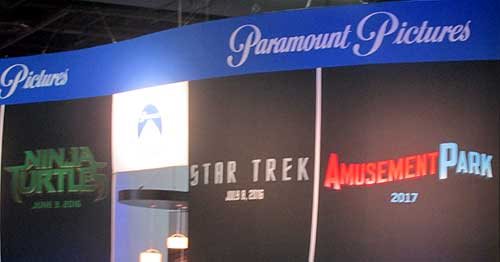
Photo by Jim Hill
One final, kind-of-ironic note: According to this banner,
Paramount Pictures will be releasing a movie called "Amusement Park"
to theaters sometime in 2017.

Photo by Jim Hill
Well, given all the "Blackfish" -related issues
that have been dogged SeaWorld Parks & Entertainment over the past two years, I'm
just hoping that they'll still be in the amusement park business come 2017.
Your thoughts?
General
It takes more than three circles to craft a Classic version of Mickey Mouse

You know what Mickey Mouse looks like, right? Little guy,
big ears?
Truth be told, Disney's corporate symbol has a lot of
different looks. If Mickey's interacting with Guests at Disneyland
Park (especially this summer, when
the Happiest Place on Earth
is celebrating its 60th anniversary), he looks & dresses like this.
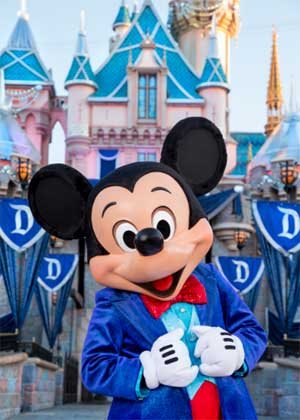
Copyright Disney Enterprises,
Inc.
All rights reserved
Or when he's appearing in one of those Emmy Award-winning shorts that Disney
Television Animation has produced (EX: "Bronco Busted," which debuts
on the Disney Channel tonight at 8 p.m. ET / PT), Mickey is drawn in a such a
way that he looks hip, cool, edgy & retro all at the same time.
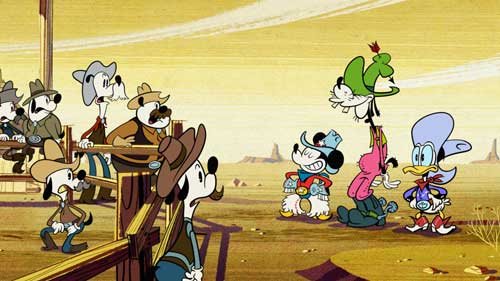
Copyright Disney Enterprises, Inc. All rights
reserved
Looking ahead to 2017 now, when Disney Junior rolls out "Mickey and the
Roadster Racers," this brand-new animated series will feature a sportier version
of Disney's corporate symbol. One that Mouse House managers hope will persuade
preschool boys to more fully embrace this now 86 year-old character.

Copyright Disney Enterprises,
Inc. All rights reserved
That's what most people don't realize about the Mouse. The
Walt Disney Company deliberately tailors Mickey's look, even his style of
movement, depending on what sort of project / production he's appearing in.
Take — for example — Disney
California Adventure
Park's "World of Color:
Celebrate!" Because Disney's main mouse would be co-hosting this new
nighttime lagoon show with ace emcee Neil Patrick Harris, Eric Goldberg really had
to step up Mickey's game. Which is why this master Disney animator created
several minutes of all-new Mouse animation which then showed that Mickey was
just as skilled a showman as Neil was.

Copyright Disney Enterprises,
Inc.
All rights reserved
Better yet, let's take a look at what the folks at Avalanche Studios just went
through as they attempted to create a Classic version of Mickey & Minnie.
One that would then allow this popular pair to become part of Disney Infinity
3.0.
"I won't lie to you. We were under a lot of pressure to
get the look of this particular version of Mickey — he's called Red Pants
Mickey around here — just right," said Jeff Bunker, the VP of Art
Development at Avalanche Studios, during a recent phone interview. "When
we brought Sorcerer Mickey into Disney Infinity 1.0 back in January of 2014,
that one was relatively easy because … Well, everyone knows what Mickey Mouse
looked like when he appeared in 'Fantasia.' "

Copyright Disney Enterprises,
Inc. All rights reserved
"But this time around, we were being asked to design
THE Mickey & Minnie," Bunker continued. "And given that these Classic
Disney characters have been around in various different forms for the better
part of the last century … Well, which look was the right look?"
Which is why Jeff and his team at Avalanche Studios began watching hours &
hours of Mickey Mouse shorts. As they tried to get a handle on which look would
work best for these characters in Disney Infinity 3.0.

Copyright Disney
Enterprises, Inc. All rights reserved
"And we went all the way back to the very start of Mickey's career. We began
with 'Steamboat Willie' and then watched all of those black & white Mickey shorts
that Walt made back in the late 1920s & early 1930s. From there, we
transitioned to his Technicolor shorts. Which is when Mickey went from being
this pie-eyed, really feisty character to more of a well-behaved leading
man," Bunker recalled. "We then finished out our Mouse marathon by
watching all of those new Mickey shorts that Paul Rudish & his team have
been creating for Disney Television Animation. Those cartoons really recapture
a lot of the spirit and wild slapstick fun that Mickey's early, black &
white shorts had."
But given that the specific assignment that Avalanche Studios had been handed
was to create the most appealing looking, likeable version of Mickey Mouse
possible … In the end, Jeff and his team wound up borrowing bits & pieces
from a lot of different versions of the world's most famous mouse. So that
Classic Mickey would then look & move in a way that best fit the sort of
gameplay which people would soon be able to experience with Disney Infinity
3.0.

Copyright Disney Enterprises,
Inc. All rights reserved
"That — in a lot of ways — was actually the toughest
part of the Classic Mickey design project. You have to remember that one of the
key creative conceits of Disney Infinity
is that all the characters which appear in this game are toys," Bunker
stated. "Okay. So they're beautifully detailed, highly stylized toy
versions of beloved Disney, Pixar, Marvel & Lucasfilm characters. But
they're still supposed to be toys. So our Classic versions of Mickey &
Minnie have the same sort of thickness & sturdiness to them that toys have.
So that they'll then be able to fit right in with all of the rest of the
characters that Avalanche Studios had previously designed for Disney Infinity."
And then there was the matter of coming up with just the
right pose for Classic Mickey & Minnie. Which — to hear Jeff tell the
story — involved input from a lot of Disney upper management.

Copyright Disney Enterprises,
Inc. All rights reserved
"Everyone within the Company seemed to have an opinion
about how Mickey & Minnie should be posed. More to the point, if you Google
Mickey, you then discover that there are literally thousands of poses out there
for these two. Though — truth be told — a lot of those kind of play off the
way Mickey poses when he's being Disney's corporate symbol," Bunker said.
"But what I was most concerned about was that Mickey's pose had to work
with Minnie's pose. Because we were bringing the Classic versions of these
characters up into Disney Infinity 3.0 at the exact same time. And we wanted to
make sure — especially for those fans who like to put their Disney Infinity
figures on display — that Mickey's pose would then complement Minnie.
Which is why Jeff & the crew at Avalanche Studios
decided — when it came to Classic Mickey & Minnie's pose — that they
should go all the way back to the beginning. Which is why these two Disney icons
are sculpted in such a way that it almost seems as though you're witnessing the
very first time Mickey set eyes on Minnie.

Copyright Disney Enterprises,
Inc. All rights reserved
"And what was really great about that was — as soon as
we began showing people within the Company this pose — everyone at Disney
quickly got on board with the idea. I mean, the Classic Mickey that we sculpted
for Disney Infinity 3.0 is clearly a very playful, spunky character. But at the
same time, he's obviously got eyes for Minnie," Bunker concluded. "So
in the end, we were able to come up with Classic versions of these characters
that will work well within the creative confines of Disney Infinity 3.0 but at
the same time please those Disney fans who just collect these figures because
they like the way the Disney Infinity characters look."
So now that this particular design project is over, does
Jeff regret that Mouse House upper management was so hands-on when it came to
making sure that the Classic versions of Mickey & Minnie were specifically
tailored to fit the look & style of gameplay found in Disney Infinity 3.0?
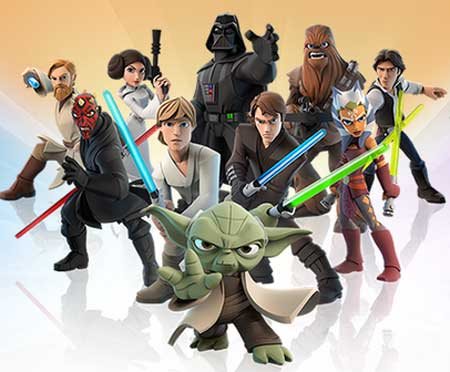
Copyright Lucasfilm / Disney
Enterprises, Inc. All rights reserved
"To be blunt, we go through this every time we add a new character to the
game. The folks at Lucasfilm were just as hands-on when we were designing the
versions of Darth Vader and Yoda that will also soon be appearing in Disney
Infinity 3.0," Bunker laughed. "So in the end, if the character's
creators AND the fans are happy, then I'm happy."
This article was originally posted on the Huffington Post's Entertainment page on Tuesday, June 9, 2015
-

 Theme Parks & Themed Entertainment10 months ago
Theme Parks & Themed Entertainment10 months agoDisney’s Forgotten Halloween Event: The Original Little Monsters on Main Street
-

 Theme Parks & Themed Entertainment10 months ago
Theme Parks & Themed Entertainment10 months agoThe Story of Mickey’s Not-So-Scary Halloween Party: From One Night to a Halloween Family Tradition
-

 Film & Movies10 months ago
Film & Movies10 months agoHow “An American Tail” Led to Disney’s “Hocus Pocus”
-

 Theme Parks & Themed Entertainment8 months ago
Theme Parks & Themed Entertainment8 months agoDisney and Macy’s 90-Year Thanksgiving Day Parade Partnership: From Mickey’s First Balloon to Minnie’s Big Debut
-

 Television & Shows6 months ago
Television & Shows6 months agoHow the Creators of South Park Tricked A-List Celebrities to Roast Universal – “Your Studio & You”
-

 History5 months ago
History5 months agoThe Super Bowl & Disney: The Untold Story Behind ‘I’m Going to Disneyland!’
-

 Film & Movies2 months ago
Film & Movies2 months agoBefore He Was 626: The Surprisingly Dark Origins of Disney’s Stitch
-

 Film & Movies1 month ago
Film & Movies1 month agoThe Best Disney Animation Film Never Made – “Chanticleer”









